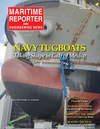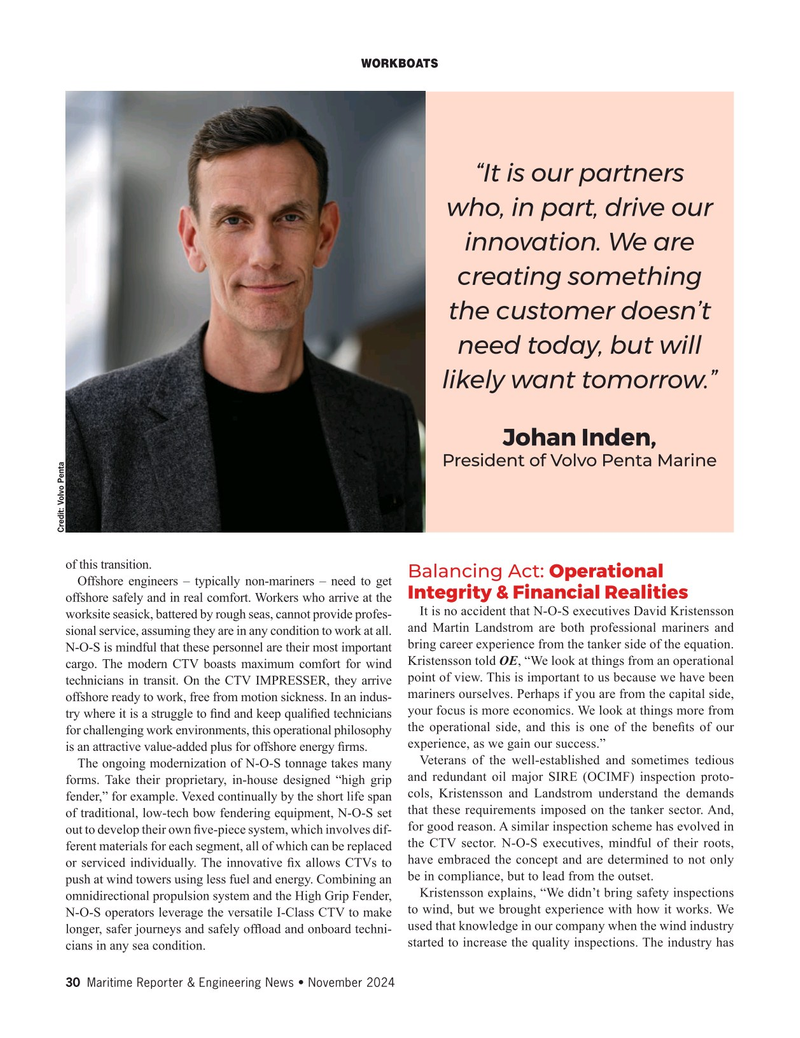
Page 30: of Maritime Reporter Magazine (November 2024)
Read this page in Pdf, Flash or Html5 edition of November 2024 Maritime Reporter Magazine
WORKBOATS “It is our partners who, in part, drive our innovation. We are creating something the customer doesn’t need today, but will likely want tomorrow.”
Johan Inden,
President of Volvo Penta Marine
Credit: Volvo Penta of this transition.
Balancing Act: Operational
Offshore engineers – typically non-mariners – need to get
Integrity & Financial Realities offshore safely and in real comfort. Workers who arrive at the
It is no accident that N-O-S executives David Kristensson worksite seasick, battered by rough seas, cannot provide profes- and Martin Landstrom are both professional mariners and sional service, assuming they are in any condition to work at all.
N-O-S is mindful that these personnel are their most important bring career experience from the tanker side of the equation. cargo. The modern CTV boasts maximum comfort for wind Kristensson told OE, “We look at things from an operational technicians in transit. On the CTV IMPRESSER, they arrive point of view. This is important to us because we have been mariners ourselves. Perhaps if you are from the capital side, offshore ready to work, free from motion sickness. In an indus- try where it is a struggle to ? nd and keep quali? ed technicians your focus is more economics. We look at things more from the operational side, and this is one of the bene? ts of our for challenging work environments, this operational philosophy experience, as we gain our success.” is an attractive value-added plus for offshore energy ? rms.
Veterans of the well-established and sometimes tedious
The ongoing modernization of N-O-S tonnage takes many forms. Take their proprietary, in-house designed “high grip and redundant oil major SIRE (OCIMF) inspection proto- fender,” for example. Vexed continually by the short life span cols, Kristensson and Landstrom understand the demands of traditional, low-tech bow fendering equipment, N-O-S set that these requirements imposed on the tanker sector. And, for good reason. A similar inspection scheme has evolved in out to develop their own ? ve-piece system, which involves dif- the CTV sector. N-O-S executives, mindful of their roots, ferent materials for each segment, all of which can be replaced or serviced individually. The innovative ? x allows CTVs to have embraced the concept and are determined to not only push at wind towers using less fuel and energy. Combining an be in compliance, but to lead from the outset.
Kristensson explains, “We didn’t bring safety inspections omnidirectional propulsion system and the High Grip Fender,
N-O-S operators leverage the versatile I-Class CTV to make to wind, but we brought experience with how it works. We used that knowledge in our company when the wind industry longer, safer journeys and safely of? oad and onboard techni- started to increase the quality inspections. The industry has cians in any sea condition.
30 Maritime Reporter & Engineering News • November 2024
MR #11 (18-33).indd 30 10/24/2024 6:35:04 PM

 29
29

 31
31
